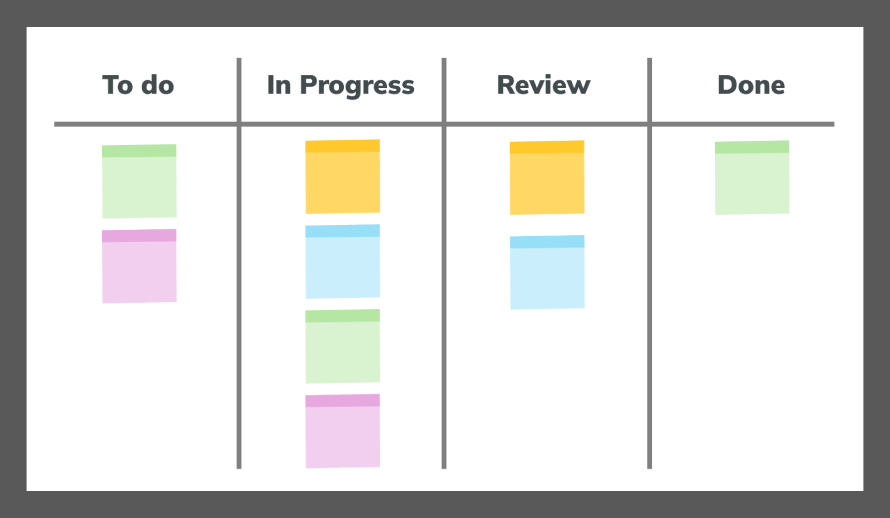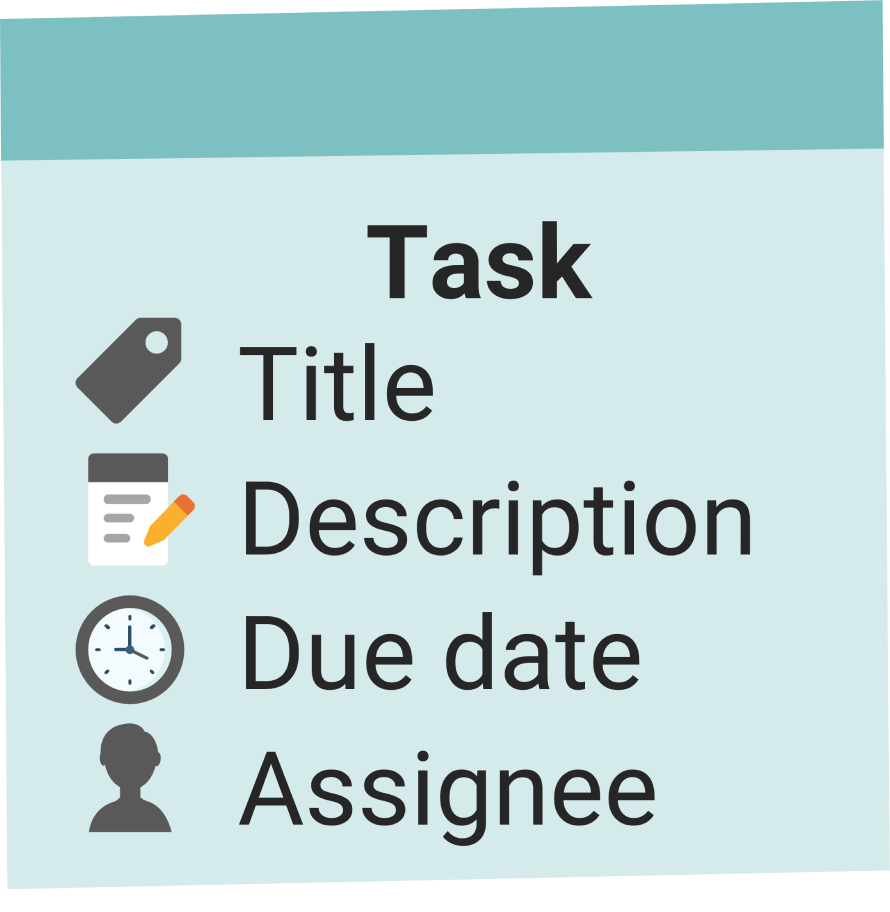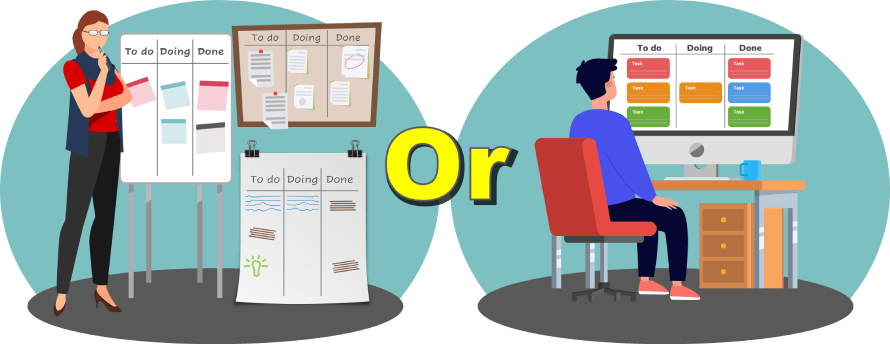Kanban management – from chaos to clarity when transforming projects
Kanban project management provides an effective route for transforming chaotic projects into structured success. Use Kanban to create a smoother workflow and increase your productivity levels. Advance your projects today by reading further.

Introduction
Kanban project management employs visual techniques to optimise workflow and improve productivity. The methodology which originated from Japanese manufacturing principles has developed into a versatile tool for multiple industries. Kanban started as part of Toyota’s production system in the 1940s before software developers adapted it during the early 2000s.
This article explores:
- The foundations and core principles of Kanban
- Key components of a Kanban system
- Implementation strategies for project management
- Benefits and metrics of Kanban
- Comparisons with other methodologies
- Best practices and common challenges.
Teams achieve process optimisation and continuous improvement through their grasp of Kanban’s flexible characteristics. This detailed guide offers essential knowledge to both beginners and those who want to improve their Kanban project management techniques.
Foundations of Kanban
Origins in Toyota’s manufacturing system
Toyota’s manufacturing plants developed the Kanban system during the late 1940s. Taiichi Ohno, who worked as an industrial engineer, created this method to enhance production efficiency. The system originated from supermarket restocking methods which ensure items are replaced only when necessary.
Adaptation to software development and other industries
During the early 2000s software development teams started using Kanban principles in their work processes. David J. Anderson introduced the first adaptation of Kanban principles specifically for knowledge work applications. Kanban has become popular across different sectors because it provides efficient workflow management.
Core principles of Kanban
Kanban is built on six fundamental principles:
- Visualise the workflow: Use a Kanban board to develop a visual depiction of your workflow process. Using Kanban boards offers a straightforward view of both task advancement and workflow obstructions.
- Limit work in progress (WIP): Establish task limits for each stage of the workflow to control work volume. Limiting work in progress stops overloading while enhancing focus and efficiency.
- Manage flow: Ensure continuous assessment and enhancement of work item progression through the system. Identify and address bottlenecks promptly.
- Make process policies clearly stated: Establish clear rules and communication procedures that outline the workflow progression through the system.
- Implement feedback loops: Create frequent review sessions to collect insights that lead to data-driven workflow enhancements.
- Improve collaboratively: Team members should collaborate to discover and execute process improvements on an ongoing basis.
Teams that follow these principles will develop an adaptable and productive system for managing workflows. Kanban enables organisations to make incremental improvements to their systems without causing process interruptions which makes it an appealing choice for many companies.
Key components of a Kanban system
Kanban board
In any Kanban system the Kanban board serves as the most crucial component. The Kanban board acts as a visual display of your team’s workflow and task advancement.
Physical vs digital boards
Organisations have the option to implement either physical or digital Kanban boards.
- Physical boards: Teams commonly use whiteboards and spacious walls with sticky notes to display tasks.
- Digital boards: Access virtual Kanban boards on any device by using software platforms that support them.
Each board type provides benefits that teams need to evaluate against their preferences and environmental needs.
Columns and workflow stages
Kanban boards organise work stages through a system of multiple columns. A basic board might include:
- To Do
- In Progress
- Review
- Done.
Teams can personalise board columns to show their unique stages of work.

Kanban cards
The Kanban cards serve as physical representations of each work item and task displayed on the board.
Purpose and information included
Each card typically contains:
- Task description
- Assignee
- Due date
- Priority level
- Additional relevant details.
Team members can immediately comprehend both task requirements and status because of this information.

Movement through the workflow
Team members transport their task cards between columns on the board as they continue working. The visual movement system provides an effective method for monitoring task progression and pinpointing workflow bottlenecks.
Work in Progress (WIP) limits
The implementation of WIP limits plays a vital role in sustaining efficient workflow operations.
Definition and importance
Each workflow stage has a defined maximum task limit through the implementation of WIP limits. WIP limits prevent task overload while supporting team members to finish existing tasks before initiating new tasks.
Setting and adjusting WIP limits
To determine appropriate WIP limits:
- Base your initial WIP limits on a practical assessment of what your team can handle.
- Monitor workflow and adjust limits as needed.
- Ensure ongoing efficiency by consistently reviewing and optimising limits.
Swimlanes and classes of service
Adding swimlanes and classes of service to Kanban boards creates new organisational layers which improve task prioritisation.
Purpose and implementation
Swimlanes function as horizontal barriers on the board which represent various elements.
- Different projects
- Team members or departments
- Types of work
Work items are categorised through classes of service based on their urgency and impact levels.
- Expedite: Highest priority, bypass normal flow
- Fixed date: Time-sensitive items
- Standard: Regular work items
- Intangible: Low priority or improvement tasks.
Prioritisation and workflow management
The introduction of swimlanes alongside classes of service enables teams to organise their work more efficiently.
- Visualise workload distribution
- Prioritise tasks effectively
- Manage different types of work simultaneously
- Ensure critical items receive appropriate attention.
Teams can build a complete Kanban system which enhances workflow transparency and efficiency while supporting ongoing process improvements by applying these essential elements.
Implementing Kanban in project management
Getting started with Kanban
A comprehensive understanding of existing processes is essential to start implementing Kanban in project management.
Mapping the current workflow
- Bring your team together to evaluate how your current workflow functions.
- Create a thorough list of each stage that a task must undergo from its beginning until completion.
- Document these stages and their sequence.
This exercise gives your team a detailed view of how work moves through its current stages.
Identifying bottlenecks and inefficiencies
With your workflow mapped, analyse it for:
- Bottlenecks: Stages where work consistently piles up.
- Inefficiencies: Unnecessary steps or redundant processes.
- Delays: Points where work often stalls.
The discovery of workflow problems enables you to focus improvement efforts within your Kanban system.
Creating a Kanban board
The Kanban board is the visual representation of your workflow.
Choosing the right tool (physical or digital)

The following factors should guide your choice between physical and digital boards.
| Physical Boards | Physical Boards Digital Boards |
| Tangible and visible | Accessible remotely |
| Easy to modify | Automated tracking |
| Limited space | Unlimited scalability |
| Team must be co-located | Supports distributed teams |
Evaluate which option aligns most closely with your team’s requirements and workplace setup.
Setting up columns and WIP limits
- Organise your workflow by setting up columns that correspond to each stage.
- Include a ‘Done’ column so you can monitor finished tasks.
- Set initial work in progress limits for all columns according to your team’s capacity.
Adjust these limits whenever you gather insights into how your team operates.
Developing team policies and guidelines
Team-wide consistency in Kanban system usage is maintained through definitive policies.
Definition of done
Define specific conditions that identify when a task reaches completion. This might include:
- Code review completed
- Testing passed
- Documentation updated
- Stakeholder approval received.
Handling blockers and dependencies
Develop procedures for:
- Identifying and marking blocked tasks
- Escalating persistent blockers
- Managing dependencies between tasks or teams.
Established guidelines ensure workflow continues without interruption and eliminate periods of stagnation.
Continuous improvement strategies
Kanban is not a set-it-and-forget-it system. Continuous improvement is key to its success.
Regular team meetings and reviews
Schedule recurring meetings such as:
- Daily stand-ups: Teams should deliver quick (15-minute) daily updates on their progress and any obstacles they encounter.
- Weekly reviews: Assess completed work and upcoming priorities.
- Monthly retrospectives: Use monthly retrospectives to measure how well your Kanban system works and determine how it can be improved.
The system adapts to your team’s requirements through collaborative meetings.
Adjusting the system based on feedback and metrics
Regularly analyse key metrics such as:
- Cycle time
- Throughput
- Work in Progress (WIP).
Employ the insights obtained from data analysis to refine your Kanban system through data-driven changes. This might involve:
- Refining WIP limits
- Adjusting column structures
- Implementing new policies or guidelines.
Through continuous evaluation and improvements to your Kanban system you will develop an optimised project management framework. Your goal with Kanban should be to embrace ongoing improvement as you and your team advance together.
Benefits of Kanban project management
Kanban implementation within project management delivers multiple benefits that lead to better team performance and improved project results.
Improved visibility and transparency
Kanban boards create a transparent visual display of the current progress in ongoing tasks. This transparency allows:
- Team members to quickly understand project status
- Managers should pinpoint workflow bottlenecks and resource allocation problems
- Project stakeholders can monitor advancement without requiring frequent updates.
Enhanced team collaboration
The visual framework of Kanban promotes better team communication and cooperation.
- Team members can easily determine which individuals are assigned to which tasks
- Team members from different functions should collaborate during each stage of task progression
- The team gains a common perspective on project objectives and important priorities.
Increased efficiency and productivity
The method of restricting work-in-progress within Kanban results in:
- Reduced multitasking and context switching
- Emphasise task completion before beginning new work
- Streamlined workflows with fewer bottlenecks and delays.
Flexibility in planning and execution
Unlike rigid methodologies, Kanban offers adaptability:
- Teams can incorporate changes anytime without interrupting their work processes.
- The board allows users to adjust priorities by moving cards around.
- The system adapts to support the team’s requirements and project specifications.
Reduced cycle times and faster delivery
Kanban achieves improved efficiency by streamlining workflows and minimising waste.
- Accelerate progress by reducing the duration between when a task starts and finishes
- Enable faster feedback loops and iterative improvements
- Enable faster value delivery to customers or stakeholders.
The advantages of Kanban reach further than these key areas. Teams consistently experience increased job satisfaction along with lower stress levels and higher-quality outputs. Organisations that develop deeper expertise with Kanban should expect to experience better predictability and risk management while their project success rates improve.
Kanban metrics and analytics
Data-driven decision-making is essential for successfully implementing Kanban practices. Teams utilise key metrics and analytics tools to track performance while pinpointing areas needing enhancement.
Cycle time
Cycle time represents the total time from the start to the completion of work on an item. This metric helps teams:
- Understand how long tasks typically take
- Identify process bottlenecks
- Set realistic expectations for task completion.
Determine cycle time by monitoring how long each task remains within the “In Progress” column.
Lead time
Lead time measures the complete duration between the initial request of a task and its final delivery. Lead time combines waiting time with cycle time to provide a complete duration measure. Lead time helps:
- Manage customer expectations
- Lead time analysis reveals starting delays for new tasks
- Improve overall process efficiency.
Throughput
Throughput represents the quantity of finished items within a specified timeframe. This metric provides insights into:
- Team productivity
- Capacity planning
- Identifying trends in work completion rates.
By monitoring throughput every week or month you can evaluate how your team performs as time progresses.
Cumulative flow diagrams
Cumulative flow diagrams (CFDs) provide a visual depiction of task statuses across different time periods. They help teams:
- Identify bottlenecks and constraints
- Visualise work in progress (WIP) levels
- Understand how work flows through the system.
CFDs display the quantity of items at each workflow step using time along the x-axis and item count on the y-axis.
Control charts
Control charts monitor cycle times for distinct items and graphically represent them through time intervals. They help teams:
- Identify outliers in task completion times
- Understand process stability
- Predict future performance.
The control charts demonstrate expected ranges for cycle times through their upper and lower control limits.
Teams that consistently evaluate these metrics will obtain valuable knowledge about their Kanban process. Continuous improvement and maximum efficiency in workflow optimisation become achievable through this data-driven method.
Comparing Kanban to other project management methodologies
Teams can select the most effective methodology for their projects by learning about the distinct features of Kanban compared to other approaches.
Kanban vs Scrum
Kanban and Scrum both fall within the Agile framework, but each methodology operates with its own unique characteristics.
| Aspect | Kanban | Scrum |
|---|---|---|
| Workflow | Continuous flow | Fixed-length sprints |
| Roles | Flexible | Defined (Scrum Master, Product Owner) |
| Changes | Allowed at any time | Discouraged during sprint |
| Planning | Continuous | Sprint-based |
| Metrics | Cycle time, Lead time | Velocity, Burndown charts |
Kanban provides teams with greater adaptability while Scrum establishes a predetermined structure through regular time intervals.
Kanban vs traditional project management
The Waterfall model represents traditional project management which stands in stark contrast to Kanban.
- Kanban emphasises smooth workflow while traditional approaches proceed through distinct phases
- Traditional methods typically prevent changes during the project while Kanban permits ongoing modifications
- Kanban uses visualisation methods whereas traditional approaches depend heavily on written documentation.
Hybrid approaches (e.g., Scrumban)
Teams choose hybrid approaches after identifying the benefits found in multiple methodologies. Scrumban represents a hybrid framework that incorporates aspects from both Scrum and Kanban methodologies.
- The system combines the sprint structure from Scrum with Kanban’s visual board approach
- The system keeps Scrum roles in place while implementing Kanban’s focus on workflow optimisation
- Kanban provides teams with greater adaptability during planning and execution stages compared to pure Scrum.
Teams can choose or modify different methodologies according to their project needs and organisational culture by understanding the strengths of each approach.
Best practices for successful Kanban implementation
Successful Kanban implementation demands strict adherence to established best practices. These guidelines facilitate a seamless transition and enhance the advantages of using the Kanban system.
Start with the current process
The first step in your Kanban journey is to create a diagram of your current workflow processes.
- Begin by assessing existing methods to determine each procedural step
- Visualise the workflow on a Kanban board
- Do not implement sudden major modifications to existing workflows.
By applying this method organisations achieve minimal disruptions and enable their team members to slowly become accustomed to the new system.
Encourage leadership at all levels
Successful Kanban implementation relies on distributed leadership:
- Allow team members the autonomy to make choices regarding their work tasks
- Encourage proactive problem-solving at all levels
- Promote an organisational environment that values ongoing advancement and creative thinking.
The approach increases team participation while developing individual responsibility for Kanban methods.
Focus on customer needs and expectations
Align your Kanban system with customer requirements:
- Determine valuable customer-oriented tasks and arrange them according to priority
- Use customer feedback to inform process improvements
- Set WIP limits and workflow stages according to customer requirements.
Teams can achieve meaningful results by directing their work towards customer requirements.
Balance demand against throughput
To maintain a sustainable workflow teams must control incoming work.
- Maintain a balance between team workload and incoming tasks to ensure sustainable performance
- Set WIP limits to protect your team members from excessive workloads
- Regularly assess and optimise resource allocation.
Maintaining this balance allows steady productivity levels while preventing team burnout.
Continuously review and improve the system
Embrace iterative improvement in your Kanban implementation:
- Hold routine team evaluations for the Kanban system
- Analyse metrics to identify areas for enhancement
- Encourage team members to identify and implement process improvements.
A continuous improvement culture enables teams to enhance their Kanban system progressively which results in better efficiency and effectiveness.
Common challenges and solutions in Kanban project management
Kanban presents multiple advantages, but teams can face difficulties when putting this system into operation. Knowledge of these challenges and their resolutions ensures that the adoption process will be successful.
Resistance to change
Challenge: Team members might show resistance toward new workflow implementation and practice adoption.
Solution:
- Educate the team on Kanban’s benefits
- Implement changes gradually
- Celebrate early successes to build momentum.
Incorrect WIP limits
Challenge: Setting incorrect Work-in-Progress (WIP) limits results in operational inefficiencies.
Solution:
- Start with conservative limits
- Track workflow progress and make necessary adjustments to limits according to data findings
- Encourage team input on setting appropriate limits.
Lack of team buy-in
Challenge: Kanban implementation faces difficulties when the team does not fully commit.
Solution:
- Involve the team in the implementation process
- Address concerns and questions openly
- Demonstrate how Kanban addresses existing pain points.
Inconsistent use of the Kanban board
Challenge: When updates to the Kanban board do not occur regularly their purpose becomes ineffective.
Solution:
- Establish clear guidelines for board usage
- Integrate board updates into daily routines
- Use automation tools to simplify updates.
Difficulty in measuring and improving flow
Challenge: Teams experience difficulties when trying to measure and improve their workflow efficiency.
Solution:
- Set up crucial metrics including cycle time and throughput to measure Kanban performance
- Implement cumulative flow diagrams as part of your visual analytics tools
- Conduct regular retrospectives to identify improvement areas.
Teams that anticipate problems and implement precise solutions will navigate their Kanban journey successfully to utilise this project management approach‘s full potential.
Conclusion
Kanban project management delivers an effective strategy for workflow optimisation and productivity enhancement. Through visualisation and WIP limits with continuous improvement Kanban delivers a flexible framework for teams in diverse industries.
Key benefits of Kanban include:
- Improved visibility and transparency
- Enhanced team collaboration
- Increased efficiency and adaptability.
Organisations that pursue Agile frameworks will likely find Kanban to be an asset for project management in the future. The adaptable nature of Kanban with its incremental improvement approach matches the dynamic requirements of modern businesses.
When teams evaluate Kanban as a project management tool, they should understand that its effective implementation demands both dedication and patience. Map your current process first then slowly implement Kanban principles while continuously improving your approach through data analysis and team feedback.
Through implementation of Kanban’s principles and best practices teams build a work environment that becomes more efficient and responsive while enabling better collaboration. To achieve better project management, you need to start with one step today.
FAQs
What is the main difference between Kanban and Scrum?
Work management approaches constitute the fundamental difference between Kanban and Scrum. Kanban aims to maintain continuous flow and restrict work in progress whereas Scrum runs on fixed sprints with established roles and ceremonies.
How do I choose the right WIP limits for my team?
Establish your starting point by setting a conservative estimate that matches the capacity of your team. Monitor workflow and adjust limits as needed. Work towards maintaining a WIP threshold that avoids bottlenecks yet keeps team members engaged.
Can Kanban be used for non-software development projects?
Absolutely. The principles of Kanban demonstrate broad adaptability across multiple fields such as marketing, healthcare, and manufacturing. The main goal is to customise the system according to your unique workflow requirements.
What are the essential metrics to track in a Kanban system?
Key metrics include:
- Cycle Time
- Lead Time
- Throughput
- Work in Progress (WIP)
- Cumulative Flow.
The collected data from these metrics offer valuable information regarding operational efficiency and productivity while highlighting potential areas for development.
How often should we review and adjust our Kanban board?
Conduct daily stand-ups for quick updates. Schedule weekly evaluation sessions to examine finished tasks and determine next priorities. Monthly retrospectives allow teams to assess system performance and implement necessary changes.
Is it necessary to use specialised software for Kanban project management?
Specialised software provides better visualisation and analysis of data but remains an optional tool. Co-located teams can achieve effective project management with physical boards that utilise sticky notes. Remote teams and complex projects increase the usefulness of digital tools.
How can I convince my team to adopt Kanban methodology?
Show your team how Kanban improves workflow visibility and enhances project flexibility. Initiate Kanban implementation through a limited pilot project to show its positive results. Engage your team throughout the implementation process while addressing concerns directly as they arise.
What are the potential drawbacks of using Kanban?
Potential challenges include:
- Resistance to change
- Difficulty in setting appropriate WIP limits
- Some teams experience motivation through the absence of timeboxing constraints
- Work may remain stagnant if there isn’t effective management.
Can Kanban be scaled for large projects or organisations?
Portfolio Kanban and the Flight Levels approach enable the scaling of Kanban systems. Multiple teams and organisational levels can use Kanban principles through these methods.
How does Kanban support continuous improvement in project management?
Kanban promotes continuous improvement through:
- Visualisation of workflow bottlenecks
- Regular review meetings
- Metrics-driven decision making
- Encouragement of incremental changes.
Ongoing refinement enables teams to maintain steady improvements in their processes and productivity.
